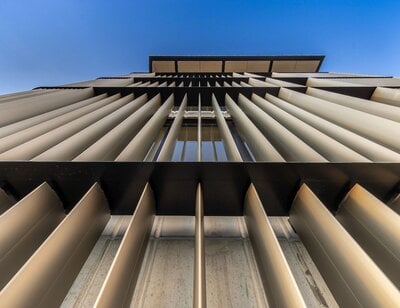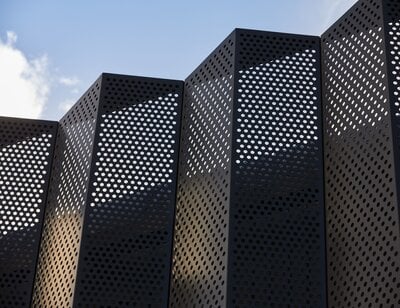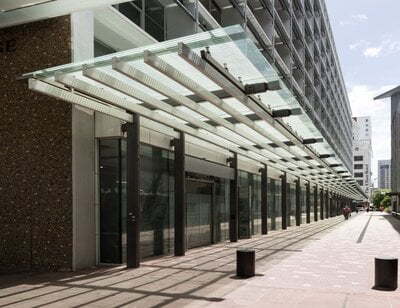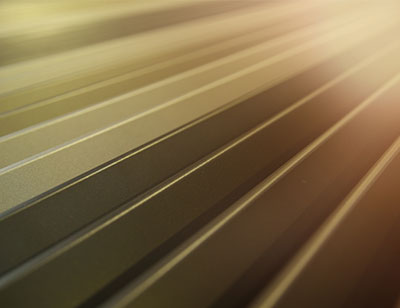Adding a fabric facade to an existing building might be one of the best ways to breathe new creativity into an ageing aesthetic, and is generally considered to be an easier and quicker alteration than the alternatives. There are numerous benefits to choosing a fabric facade for new builds too. This article explores exactly what those benefits are, along with any of the potential issues to be aware of.
What is a Fabric Facade?
A fabric facade uses a stretched fabric material in surface tension to form a three-dimensional surface, which is used to create an architectural aesthetic on a structure. It uses specialised fabrics under tension to support its self-weight, allowing it to span large distance without intermediate supports.
Insol's fabric facades are made from a fabric membrane of polyester yarn fabric, with a varnished PVC coating, which contains fire retardants (certified to meet AS/NZS 1530).
The Advantages of Fabric Facades
Every facade type has its pluses and minuses, which undoubtedly vary depending on the project. So while the following might not be applicable or a major point of difference for a specific project, they are nonetheless true in general terms.
Creative Freedom
Adding a fabric facade to a building provides an opportunity to individualise the building aesthetic, changing its character to make it unique. There is little to distract from the creative process, with a relatively small number of considerations when working through the design options. A fabric facade opens possibilities, particularly for older buildings who can be 'dresses' in something new and contemporary.
Very Light Weight
A fabric facade will place significantly less load onto the building compared to other facade systems. The Insol facade membrane is 600 grams/m2. The extruded tension system is additional to this, but even with that, it's still an incredibly light facade treatment.
Vast Colour & Print Options
The large fabric membrane is effectively a blank canvas for design. The ability to vary the colour and print graphics directly onto that membrane can turn any building into a large format communication medium. This is particularly appealing to retail premises, where the facade can be used to attract attention and clientele. Elsewhere, there is an opportunity to add a level of detail that is rarely achievable with other methods.
Thermal Comfort & Sun Protection
Depending on the fabric colours and level of reflectivity, up to 80% of the solar gain can be blocked or absorbed by the fabric membrane. This makes for excellent passive management of thermal comfort that will contribute significantly to a building's energy reduction initiatives in order to meet environmental and sustainability goals. For occupants, the shading qualities still provides enough sunlight to satisfy their physiological needs, but without the potentially harmful blinding from unadorned glass curtain wall facades.
Even Filtering of Light
A sometimes overlooked benefit of fabric facades is their ability to provide an even filtering of sunlight. This has a positive impact on occupants, particularly in an office or educational setting. When rooms are lit with uneven light, with disparity between lighter and dark areas, the constant focusing and refocusing of the eyes can become tiresome, reduce concentration and induce headaches and/or migraines.
Windbreak
The fabric membrane acts as an effective windbreak, allowing windows and doors to be opened, letting fresh air in but not any unruly gusts that can rattle and annoy. This is particularly relevant when the fabric facade is in an elevated position and more subjectable to wind loads. It’s worth noting here that all loads up to 6 kn/m are effectively transferred to the extruded tension system in the Insol fabric facade solution. We then use site specific wind forces to calculate the size and spacing of the fixing bolts.
Rain Screen
Yes, rain will get through, but arguably not as much as many may think. Fabric facades can do an impressive job of reducing the severity of rain, to such an extent that on those warm and wet days it’s even possible to open the window to let the fresh air in while keeping the rain out.
Unobstructed Views
It can vary but the visibility from behind a fabric facade is generally very good. The closeness of the open holes to the occupant allows them to see out but restricts prying eyes from seeing in, thanks to the trick of proximity (or lack thereof). Insol fabric facades have an approximate open area of 20% to maintain good visibility.
The Disadvantages of Fabric Facades
There has to be some downsides to fabric facades. And there is - although we don’t consider any of them to be unmanageable.
Can Be Cut
The tension system of the fabric facade will generally prevent it from being dented and they can withstand a reasonable impact before damage is incurred. The material is cut resistant but it can still be cut and this can happen, although it is very unusual. Replacing a section is as easy as replacing a pane of glass, so should the worst happen it's generally a quick and inexpensive fix. We should note, the Insol HQ in Invercargill has a fabric facade. Despite the local Southland weather, careless drivers (who may or may not be team members) and cranking the wind tunnel up high enough to frighten nearby residents…we’ve never had a problem with anything cutting it.
Engineering Challenges
Getting the tension correct can be a frustrating process at times and depending on the design of the facade and the building itself, it can pose an engineering challenge. That said, it’s a challenge for the Insol team to worry about so while it’s worth mentioning here, the burden of responsibility to solve it isn’t a concern for the architect unless the challenge is such that a design change is needed.
Nighttime Privacy Can be An Issue
A fabric facade appears to partially disappear when backlit. This makes it largely unsuitable for nighttime privacy, unless the elevation and angle from the street provide a degree of natural privacy anyway.
Examples of Fabric Facades that Look Great
The XERO headquarters in Wellington features a fabrecade facade over the top 3 storeys. Adding a modern aesthetic layer to the lines of the historic building, its backlit with a changing palette of colours creating a stunning night time graphical effect. We can lay claim to this facade but our next example is someone else. That won’t stop us highlighting it though as it’s quite stunning.
The fabric mesh which wraps around Ben Ainslie Racing HQ in Portsmouth, England, is a triple layer system with a light transparency of 87%. The sheer scale alone is impressive, with 2790 m2 of vertical curved fabric cladding used on the building that houses the America's Cup dreams of the British. So at least they’ll have a nice base to retreat to after losing in 2024.
Fabric facades have many uses. They can provide an affordable, quick method of sprucing up a tired exterior to attract new tenants. Or they can be large and complex, creating a massive canvas to communicate an idea or message. They can be colourful and bold, or subtle and discerning.
They can be anything really. Which is exactly why they make for a great option.








